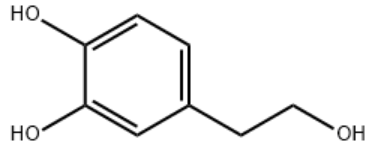3,4-Dihydroxyphenylethanol CAS#: 10597-60-1; ChemWhat Code: 66191
Identification
Physical Data
| Appearance | slight yellow viscous liquid |
| Purity | 99% min |
| Melting Point, °C | Solvent (Melting Point) |
| 70 – 71 | methanol |
| 80 – 82 | |
| 82 – 84 | methanol, H2O |
| 81 – 83 | CH2Cl2, CCl4 |
| Description (Association (MCS)) | Solvent (Association (MCS)) | Temperature (Association (MCS)), °C | Partner (Association (MCS)) |
| Adsorption isotherm | H2O | 20 | styrene-divinylobenzene XAD-4 resin, Rohm and Haas Co. |
| Adsorption isotherm | H2O | 20 | styrene-divinylobenzene XAD-7HP resin, Rohm and Haas Co. |
| Adsorption isotherm | H2O | 20 | styrene-divinylobenzene XAD-16 resin, Rohm and Haas Co. |
Spectra
| Description (NMR Spectroscopy) | Nucleus (NMR Spectroscopy) | Solvents (NMR Spectroscopy) | Temperature (NMR Spectroscopy), °C | Frequency (NMR Spectroscopy), MHz |
| Chemical shifts, Spectrum | 1H | chloroform-d1 | ||
| Chemical shifts, Spectrum | 1H | water-d2 | 24.84 | |
| Chemical shifts | 1H | CD3OD | 500 | |
| Chemical shifts | 1H | dimethylsulfoxide-d6 | 400 | |
| Chemical shifts, Spectrum | 1H | CD3OD | 300 | |
| Chemical shifts, Spectrum | 13C | CD3OD | 126 |
| Description (IR Spectroscopy) | Solvent (IR Spectroscopy) |
| Intensity of IR bands, Bands, Spectrum | |
| Spectrum | |
| Spectrum | |
| Bands | sodium chloride |
| Bands | |
| Bands | |
| Bands | potassium bromide |
| Description (UV/VIS Spectroscopy) | Solvent (UV/VIS Spectroscopy) |
| Spectrum | |
| methanol | |
| Spectrum |
Route of Synthesis (ROS)
| Conditions | Yield |
| With Pd/C; hydrogen In tetrahydrofuran for 3h; | 98% |
| With hydrogen; 10% Pd/C In ethyl acetate at 20℃; for 2h; Inert atmosphere; Experimental Procedure Example 1 1: Preparation of hydro xytyrosol from 2-(3.4-bisbenzyloxy-phenyl)ethanol (8)To a 50 mL round-bottom flask, 2-(3,4-bisbenzyloxyphenyl)ethanol (1.04 g, 3.11 mmol) and ethyl acetate (15 mL) were charged. The reaction system was protected by N2 gas and 10% Pd/C (0.33 g) was quickly added to the flask. The reaction mixture was stirred at room temperature under an atmosphere of hydrogen gas (balloon) for 2 h. After filtration of the catalyst and evaporation of the solvent, 0.46 g (96%) of a light yellow oil was obtained.¾ NMR (400 MHz, DMSO-<¾): δ 8.69 (br s, 1 H), 8.59 (br s, 1 H), 6.60 (d, J= 7.8 Hz, 1 H), 6.58 (d, J= 2.0 Hz, 1 H), 6.42 (dd, J= 7.8, 2.0 Hz, 1 H), 4.55 (t, J= 5.2 Hz, 1 H, -OH), 3.50 (m, 2 H), 2.53 (t, .7= 7.3 Hz, 2 H). 13C NMR (100 MHz, DMSO-«¾): δ 144.9, 143.4, 130.31, 119.6, 116.4, 115.5, 62.7, 38.6. | 96% |
Safety and Hazards
| Pictogram(s) |  |
| Signal | Warning |
| GHS Hazard Statements | H315 (91.3%): Causes skin irritation [Warning Skin corrosion/irritation] H319 (93.48%): Causes serious eye irritation [Warning Serious eye damage/eye irritation] H335 (100%): May cause respiratory irritation [Warning Specific target organ toxicity, single exposure; Respiratory tract irritation] |
| Precautionary Statement Codes | P261, P264, P264+P265, P271, P280, P302+P352, P304+P340, P305+P351+P338, P319, P321, P332+P317, P337+P317, P362+P364, P403+P233, P405, and P501 (The corresponding statement to each P-code can be found at the GHS Classification page.) |
Other Data
| Transportation | Under room temperature away from light |
| HS Code | |
| Storage | Under room temperature away from light |
| Shelf Life | 2 years |
| Druglikeness | |
| Lipinski rules component | |
| Molecular Weight | 154.166 |
| logP | 0.718 |
| HBA | 1 |
| HBD | 3 |
| Matching Lipinski Rules | 4 |
| Veber rules component | |
| Polar Surface Area (PSA) | 60.69 |
| Rotatable Bond (RotB) | 2 |
| Matching Veber Rules | 2 |
| Use Pattern |
| 3,4-Dihydroxyphenylethanol CAS#: 10597-60-1 has anti-inflammatory, vasodilatory, and antibacterial effects. It can prevent atherosclerosis, reduce the incidence of certain cancers. it has strong antioxidant activity and the potential to lower the incidence of cancer. |
Buy Reagent | |
| No reagent supplier? | Send quick inquiry to ChemWhat |
| Want to be listed here as a reagent supplier? (Paid service) | Click here to contact ChemWhat |
Approved Manufacturers | |
| Want to be listed as an approved manufacturer (Requires approvement)? | Please download and fill out this form and send back to approved-manufacturers@chemwhat.com |
Other Suppliers | |
| Watson International Limited | Visit Watson Official Website |
Contact Us for Other Help | |
| Contact us for other information or services | Click here to contact ChemWhat |



